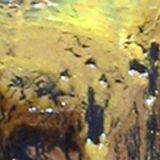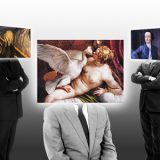The Art of the Artist Statement
A well-written artist statement has been known to propel some people into the collectible stratosphere. However, having a few good connections may serve you better.
By: Prof. Gulley Jimson, RA, Ph.D., AFT, RCA, PADI
Greetings fellow creative-types of all shapes and sizes. I trust you have all been busy producing masterpieces.
By popular demand, I will address yet another aspect of the art world that has plagued would-be artists since the dawn of time. Well, maybe since the nineteen fifties; the dreaded Artist’s Statement.
Anything but that! you say? Please don’t run away, just yet. First, please indulge me as I relate an experience at a very high-profile exhibition of art that was held in honor of the 115th anniversary (give or take a few years) of the first metal-tube colors ever manufactured.
The event was the talk of the town. Internationally known art critics and famous artists were on hand to celebrate the occasion. The wine flowed freely. In the center of the great room where the event was held, stood a long, elegant display case of mahogany, covered by a beautiful red silk brocade sheet. A hush fell over the room as a Vanna White lookalike, dressed in a silver sheath to resemble a paint tube, whipped the cloth from the display case.
An audible gasp rose from the artists and critics at the unveiling. There before our very eyes was an incredible array of replicas of the original flexible metal tubes containing prepared paints. Parallel to these were the latest iterations of paint-in-a-tube examples, all neatly arranged in rows upon maroon-colored velvet.

A contingent of liveried attendants lifted away the glass topping the case, and one of the company presenters held up a sample tube. After a long dramatic pause, the presenter began to extol the virtues of this new invention that had freed up precious time for artists to create. It is even claimed that Impressionism would not have happened were it not for the invention of the humble paint tube, which we now take for granted. As the representative spoke, some of the audience had gathered around the display table and were whispering among themselves. A few poked and squeezed the little shiny tin tubes, while others opened them and sniffed. A couple of fellows even tasted them.
“I want to be famous but unknown!” ~ Edgar Degas
Suddenly, someone pushed his way through the crowd—knocking one or two bystanders to the floor—grabbed a fistful of the shiny tubes, squirted their contents onto a nearby blank wall, and smeared the colors with his bare hands. When the impromptu performance was ended, the dazed spectators stood with mouths agape.
As long as I live, I will never do that again in front of such a lowbrow bunch. But the point of my story is to always take advantage of an opportunity to create, even if it’s messy. The elegant crowd all stood around mumbling, but I created! After I picked myself up off the sidewalk, I cheerily walked home with an air of satisfaction.
It is the same with writing your artist statement—be bold, be original, and above all, be incoherent. And should the occasion arise that you will have to face an audience and explain yourself, all the better if you can do so with a straight face. In fact, feel free to plagiarize. As the great impresario himself—Andy Warhol—has said: “Art is what you can get away with.” To this day, most of the highest-earning living artists follow his maxim. It’s not really about talent of hand but of the tongue, if you get my meaning.
“If your work is popular with the masses,
you are probably doing something wrong.”
~ Zed Nil
But enough with the pep talk, let us move on to the more practical side of things. Personally, I have never had the need to write an artist statement. Like the situation I described above, it is usually pretty obvious that my actions are my statement!
If you feel it is imperative to have one, the most important thing when writing an artist statement is to begin with the first word and end with the last. I have found that this method has never failed me in any of my writing projects. And remember to write slowly, as many people cannot read fast. This point can never be overstated. Many a wonderful artist statement was thrown in the trash bin by art reviewers because they could not read fast enough.
Meanwhile, for those of you who want to nitpick, I will offer a few terse examples below:
Art cannot be explained, it can only be experienced. Are you experienced?
Why did I become an artist? Why does anybody do anything?
My work displays truth, justice, and the artistic way. Isn’t that enough?
Popeye said it best: “I am what I am.” My work is what it is.
I see my work as an expression of the humanity of man, and the inhumanity of contemporary “art.”

Every artist must be the captain of his own ship, even if it sinks. To all you aspiring young artists…get over it. And remember, dear artists, if at first you don’t succeed, write, write again!
Until next time, folks…paint like mad!






